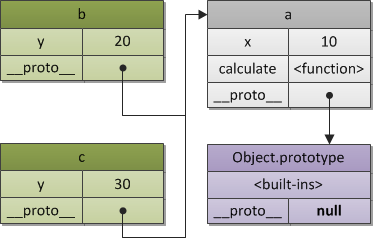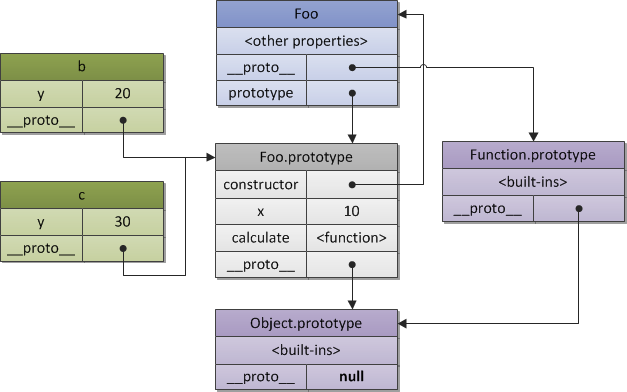js prototype chain principle diagram explanation_javascript skills
The inventor of ECMAscript designed this linked list in order to simplify the language while maintaining inherited properties. .
Have you ever learned about linked lists in data structures? There is a position in the linked list that is equivalent to a pointer, pointing to the next structure.
So the same goes for __proto__. Whenever you define a prototype, it is equivalent to pointing the __proto__ of the instance to a structure. Then the pointed structure is called the instance. prototype.
The text is a bit convoluted, look at the pictures to speak
var foo = {
x: 10,
y: 20
};

When I do not specify __proto__, foo will also reserve such an attribute.
If there is a clear pointer, then the linked list will be linked. La.
Obviously, b and c in the figure below share the attributes and methods of a, and at the same time have their own private attributes.
__proto__ also has pointing by default. It points to the highest-level object.prototype, and the __proto__ of object.prototype is empty.
var a = {
x: 10,
calculate: function (z) {
return this.x this.y z
}
};
var b = {
y: 20,
__proto__: a
};
var c = {
y: 30,
__proto__: a
};
// call the inherited method
b.calculate( 30); // 60

Understand the nature of the attribute link pointer __proto__. . Let’s understand constructor again.
When a prototype is defined, a prototype object will be constructed, and this prototype object is stored in the prototype method of the function that constructs the prototype.
function Foo(y){
this.y = y ;
}
Foo. prototype.x = 10;
Foo.prototype.calculate = function(z){
return this.x this.y z;
};
var b = new Foo (20);
alert(b.calculate(30));

http://dmitrysoshnikov.com/ecmascript/javascript-the-core/

Hot AI Tools

Undresser.AI Undress
AI-powered app for creating realistic nude photos

AI Clothes Remover
Online AI tool for removing clothes from photos.

Undress AI Tool
Undress images for free

Clothoff.io
AI clothes remover

AI Hentai Generator
Generate AI Hentai for free.

Hot Article

Hot Tools

Notepad++7.3.1
Easy-to-use and free code editor

SublimeText3 Chinese version
Chinese version, very easy to use

Zend Studio 13.0.1
Powerful PHP integrated development environment

Dreamweaver CS6
Visual web development tools

SublimeText3 Mac version
God-level code editing software (SublimeText3)

Hot Topics
 1381
1381
 52
52
 How do I create and publish my own JavaScript libraries?
Mar 18, 2025 pm 03:12 PM
How do I create and publish my own JavaScript libraries?
Mar 18, 2025 pm 03:12 PM
Article discusses creating, publishing, and maintaining JavaScript libraries, focusing on planning, development, testing, documentation, and promotion strategies.
 How do I optimize JavaScript code for performance in the browser?
Mar 18, 2025 pm 03:14 PM
How do I optimize JavaScript code for performance in the browser?
Mar 18, 2025 pm 03:14 PM
The article discusses strategies for optimizing JavaScript performance in browsers, focusing on reducing execution time and minimizing impact on page load speed.
 What should I do if I encounter garbled code printing for front-end thermal paper receipts?
Apr 04, 2025 pm 02:42 PM
What should I do if I encounter garbled code printing for front-end thermal paper receipts?
Apr 04, 2025 pm 02:42 PM
Frequently Asked Questions and Solutions for Front-end Thermal Paper Ticket Printing In Front-end Development, Ticket Printing is a common requirement. However, many developers are implementing...
 How do I debug JavaScript code effectively using browser developer tools?
Mar 18, 2025 pm 03:16 PM
How do I debug JavaScript code effectively using browser developer tools?
Mar 18, 2025 pm 03:16 PM
The article discusses effective JavaScript debugging using browser developer tools, focusing on setting breakpoints, using the console, and analyzing performance.
 Who gets paid more Python or JavaScript?
Apr 04, 2025 am 12:09 AM
Who gets paid more Python or JavaScript?
Apr 04, 2025 am 12:09 AM
There is no absolute salary for Python and JavaScript developers, depending on skills and industry needs. 1. Python may be paid more in data science and machine learning. 2. JavaScript has great demand in front-end and full-stack development, and its salary is also considerable. 3. Influencing factors include experience, geographical location, company size and specific skills.
 How do I use source maps to debug minified JavaScript code?
Mar 18, 2025 pm 03:17 PM
How do I use source maps to debug minified JavaScript code?
Mar 18, 2025 pm 03:17 PM
The article explains how to use source maps to debug minified JavaScript by mapping it back to the original code. It discusses enabling source maps, setting breakpoints, and using tools like Chrome DevTools and Webpack.
 How to merge array elements with the same ID into one object using JavaScript?
Apr 04, 2025 pm 05:09 PM
How to merge array elements with the same ID into one object using JavaScript?
Apr 04, 2025 pm 05:09 PM
How to merge array elements with the same ID into one object in JavaScript? When processing data, we often encounter the need to have the same ID...
 The difference in console.log output result: Why are the two calls different?
Apr 04, 2025 pm 05:12 PM
The difference in console.log output result: Why are the two calls different?
Apr 04, 2025 pm 05:12 PM
In-depth discussion of the root causes of the difference in console.log output. This article will analyze the differences in the output results of console.log function in a piece of code and explain the reasons behind it. �...




